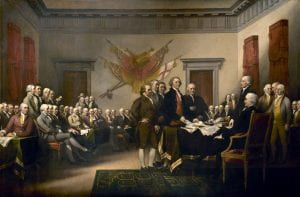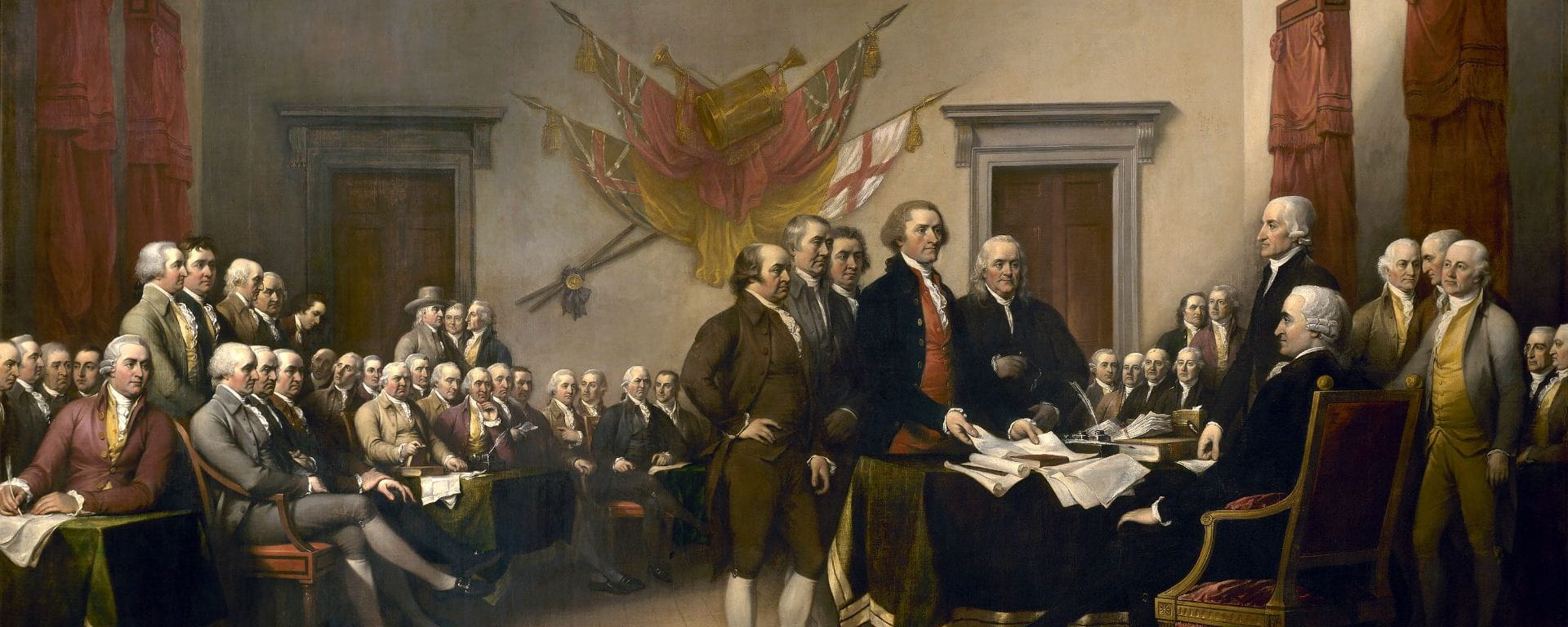
It was only in the early 1790s that Thomas Jefferson began trumpeting his authorship of the Declaration of Independence. Throughout the late 1770s and the 1780s, Americans essentially forgot the Declaration, and no one seemed to remember who had written it. But in the 1790s they started attributing new meanings to the document, making it into a metaphysical, almost sacred text. Jefferson’s fellow Republicans started celebrating him as the “immortal” author of the text. And Jefferson himself wrote more frequently about drafting the Declaration, sometimes exaggerating his role in the process.1 Why this change? Why in the 1790s?
In my courses, I suggest to students that Americans began reconsidering the meaning of the American Revolution because of the news coming from revolutionary France. In light of what was happening there, Americans started retrospectively viewing their own independence as much more revolutionary than before and attributing a new universal significance to it. One particular class meeting in my upper-level history course “Age of Revolution, 1765-1848” revolves entirely around this point. I title our meeting for that day “The French Revolution in America and the Reinvention of Revolution.” It represents the centerpiece of the course, marking the end of the first part of the semester on the American and French revolutions.2
 Loading...
Loading...
The first of the four readings assigned for this class is a long excerpt of Keith Baker’s article “Revolution 1.0.”3 In class, I ask students to identify Baker’s central claim—that the French Revolution introduced a new notion of “revolution,” a new revolutionary “script.”4 We then consider whether sources from the time confirm, disprove, or qualify Baker’s argument. We start with European sources, then move to North American documents. I assign a few excerpts from the so-called “Republican Triennium”—the three years (1796-1799) when republics were established on the Italian peninsula after the French revolutionary army invaded. I ask students to describe how Italians understood “revolution” in general and the American Revolution in particular. They usually highlight how Italians viewed American events as the first democratic revolution and the beginning of a more egalitarian society. I then tell them that I found, in my own research, that this interpretation was absent in the 1780s. I suggest that the Italian example offers evidence to support Barker’s claim that the French Revolution revolutionized the international debate on “revolution”—especially the reception of the American Revolution.
 Loading...
Loading...
Class discussion then moves to North America, and I guide students in seeing that a similar process of reinterpreting the meaning of the American Revolution also happened within the United States. We begin with selected letters by Jefferson about France.
 Loading...
Loading...

We next turn to Matthew Rainbow Hale’s article “Regenerating the World,” which shows that Jefferson was not alone in viewing the American Revolution with new eyes.5 I ask students to identify Hale’s claim that democracy became an American “founding” value only in the 1790s due to the French Revolution. I show them two graphs from Hale’s article, which track the frequency of words associated with democracy and aristocracy and are particularly effective teaching tools.6 Finally, I show students several scenes from “Unite or Die,” the fifth episode of the HBO show John Adams.7 The scenes depict celebrations of the French Revolution on the streets of Philadelphia, the discussion between the French ambassador Genȇt and Washington, and a dialogue between John Adams and Jefferson. These clips help students visualize the events in Hale’s article and show them how understandings of “revolution” started to diverge among the Founding Fathers themselves.
By the end of the class meeting, students understand why the American Revolution might be viewed today–as in the 1790s–as the beginning of the Age of Revolution. But they are also critical of the idea because they are aware of how it has been constructed. A central notion of my course is that we should interpret the American Revolution as belonging to the pre-modern age and continuing British political traditions rather than as the beginning of a broader Age of Revolution, let alone of modernity. The Age of Revolution and the modern age, I argue, have their origins in the experience of the French Revolution, which introduced a new kind of revolution based on unprecedented radical politics. This particular class meeting is crucial in helping me to make that point.
Anna Vincenzi is Assistant Professor of Modern European History at Hillsdale College. She is currently working on a book project which investigates interpretations of the American Revolution in the Italian States and how those interpretations were affected by the outbreak of the French Revolution. Her article, “Mutation in Dominion” or Revolution? The American Revolution as Seen from Papal Rome,” is featured in the Summer 2022 issue of Early American Studies, which can be viewed here: https://doi.org/10.1353/eam.2022.0014.
https://www.hillsdale.edu/faculty/anna-vincenzi/
- Pauline Maier, American Scripture: How America Declared Its Independence from Britain (London: Pimlico, 1999), 154-155, 160-161, 169, 181-186. ↩
- I also teach an abbreviated version of this class in my American history survey, using it as a link between the American Revolution, the “revolution of 1800,” and democratization in white America during the Jeffersonian and Jacksonian eras. ↩
- Keith Michael Baker, “Revolution 1.0,” Journal of Modern European History, 11:2 (2013): 187-219. ↩
- The idea of a “script” comes from Keith Michael Baker and Dan Edelstein, eds., Scripting Revolution: A Historical Approach to the Comparative Study of Revolutions (Stanford: Stanford University Press, 2015). ↩
- Matthew Rainbow Hale, “Regenerating the World: The French Revolution, Civic Festivals, and the Forging of Modern American Democracy, 1793-1795,” Journal of American History, 103:4 (2017): 891-920. ↩
- Hale, “Regenerating,” 897 and 900. ↩
- “Unite or Die,” John Adams, 2008, HBO, https://www.hbo.com/john-adams. Times for these scenes are 17:08-21:09 and 29:40-35:08. ↩


